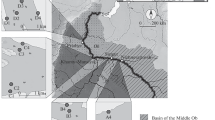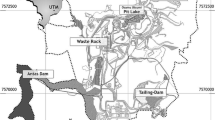Abstract
The temporal distribution of bacteria on the surface sediment of the oxbow lake Lagoa do Infernão was studied over a period of one year using different techniques for bacterial counts. Several bacterial groups were differentiated, such a total bacteria and filamentous, heterotrophic, amylolytic, and lipolytic bacteria. The best defined temporal distribution pattern was obtained by total-AO bacterial counts, with a variation of 1.26 × 1010 to 8.58 × 1010 bacteria (g dw)−1 during the dry and rainy seasons, respectively. The electrode potential (Eh) of the surface sediment ranged from − 148 mV during the rainy season to + 371 mV during the dry season. The variations detected on the surface sediment suggest a greater allochthonous contribution of material and bacteria resulting in high decomposing activity during the rainy season.
Similar content being viewed by others
References
Bell, J. B. & B. J. Dutka, 1972. Microbiological examination of Lake Ontario sediments. I. Distribution of aerobic and anaerobic heterotrophs in several lake Ontario sediments. Proc. Conf Gt. Lakes Res. 15: 1–8.
Billen, G., 1982. Modelling the process of organic matter degradation and nutrients recycling in sedimentary systems. In Nedwell, D. B. & C. N. Brown, ed. Sediment microbiology. London, Academic press: 15–52.
Capone, D. G. & R. P. Kiene, 1988. Comparison of microbial dynamics in marine and freshwater sediments: contrasts in anaerobic carbon catabolism. Limnol. Oceanogr. 33: 725–749.
Chrost, R. J., R. Wcislo & G. Z. Halemejko, 1986. Enzimatic decomposition of organic matter by bacteria in an eutrophic lake. Arch. Hydrobiol. 107: 145–165.
Collins, V. G. & L. G. Willoughby, 1962. The distribution of bacteria and fungal spores in Blelham Tarn with particular reference to an experimental overturn. Arch. Mikrobiol. 43: 294–307.
Consema, 1985. Áreas naturais do Estado e São Paulo. São Paulo, Conselho Estadual do Meio Ambiente. 16 pp.
Drabkova, V. G., 1983. Bacterial decomposition of organic matter in lacustrine sediments. Hydrobiologia 103: 99–102.
Dutka, B. J. & K. K. Kwan, 1983. Microbiological examination of Lake Erie and Lake Ontario sediments. Hydrobiologia 98: 135–145.
Elliot, J. M., 1971. Some methods for the statistical analysis of samples of benthic invertebrates. Scient. Publis. Freshwat. Biol. Ass. N° 25. 148 pp.
Godinho-Orlandi, M. J. L. & J. G. Jones, 1981. Filamentous bacteria in sediments of lakes of differing degrees of enrichment. J. Gen. Microbiol. 123: 81–90.
Golterman, H. L., R. S. Clymo & M. A. M. Ohnstad, 1978. Methods for physical and chemical analyses of freshwaters. 2 ed. LOxford, Blackwell Scientific. 213 p. (IBP Handbook, 8).
Gomori, G., 1955. Preparation of buffers for use in enzyme studies. Methods Enzimol. 1: 138–146.
Hall, H. J., P. M. Kleiber & I. Yesaki, 1972. Heterotrophic uptake of organic solutes by microorganisms in the sediment. Mem. Ist. Ital. Idrobiol. 29 (Suppl.): 441–471.
Harris, R. F. & L. E. Sommers, 1968. Plate dilution frequency technique for assay of microbiol ecology. Appl. Microbiol. 16: 330–334.
Harvey, H. R., M. D. Richardson & J. S. Patton, 1984. Lipid composition and vertical distribution of bacteria in aerobic sediments of the Venezuela Basin. Deep. Sea Res. Part. A Oceanogr. Res. Pap. 31: 403–413.
Jones, J. G., 1979. Microbial activity in lake sediments with particular reference to electrode potential gradients. J. Gen. Microbiol. 115: 19–26.
Jones, J. G. & B. M. Simon, 1975. An investigation of errors in direct counts of aquatic bacteria by epifluorescence microscopy, with reference to a new method for dyeing membrane filters. J. Appl. Bact. 39: 317–329.
Jones, J. G., M. J. L. G. Orlandi, B. M. Simon, 1979. A microbiological study of sediments from the Cumbrian Lakes. J. Gen. Microbiol. 15: 37–48.
Lundgren, B., 1981. Fluorescein diacetate as a stain of metabolically active bacteria in soil. Oikos. 36(1): 17–22.
Mortimer, C. H., 1942. The exchange of dissolved substances between mud and water in lakes. J. Ecol. 30: 147–201.
Nogueira, F. M., 1989. Importância das macrófitas aquáticas Eichhornia azurea e Scirpus cubensis Poepp & Kunth na ciclagem de nutrientes e nas principais, características limnológicas da Lagoa do Infernão (SP). São Carlos, UFSCAR. 130 p. (Master Thesis).
Norris, J. L. & D. W. Ribbons (eds.), 1971. Methods in microbiology. Vol. 5A. London, Academic Press. 450 pp.
Ohnstad, F. R. & J. G. Jones, 1982. The Jenkin surface-mud sampler. Scient. Publ. Freshwat. Biol. Ass. N° 15. 45 pp.
Paton, A. M. & S. M. Jones, 1975. The observation and enumeration of microorganisms in fluids using membrane filtration and incident fluorescence microscopy. J. Appl. Bact. 38: 199–200.
Quinn, J. P., M. B. Gillan & H. McGrogan, 1985. The planktonic and benthic bacterial populations of Lough Neagh. J. Appl. Bact. 58: 87–94.
Ramsay, A. J., 1976. Heterotrophic bacteria and their relationship with plankton in a New Zealand freshwater lake. N.Z.J. Mar. Freshwat. Res. 10: 77–90.
Rubble, P. A., 1982. Seasonal distribution of bacteria in salt marsh sediments in North Carolina, USA. Estuar. Coast. Shelf Sci. 15: 67–74.
Vanderpost, J. M., 1972. Bacterial and physical characteristics of Lake Ontario sediment during several months. Proc. Conf. Gt. Lakes Res. 15: 198–213.
Author information
Authors and Affiliations
Rights and permissions
About this article
Cite this article
Freitas, E.A.C., Godinho-Orlandi, M.J.L. Distribution of bacteria in the sediment of an oxbow tropical lake (Lagoa do Infernão, SP, Brazil). Hydrobiologia 211, 33–41 (1991). https://doi.org/10.1007/BF00008614
Received:
Revised:
Accepted:
Issue Date:
DOI: https://doi.org/10.1007/BF00008614




